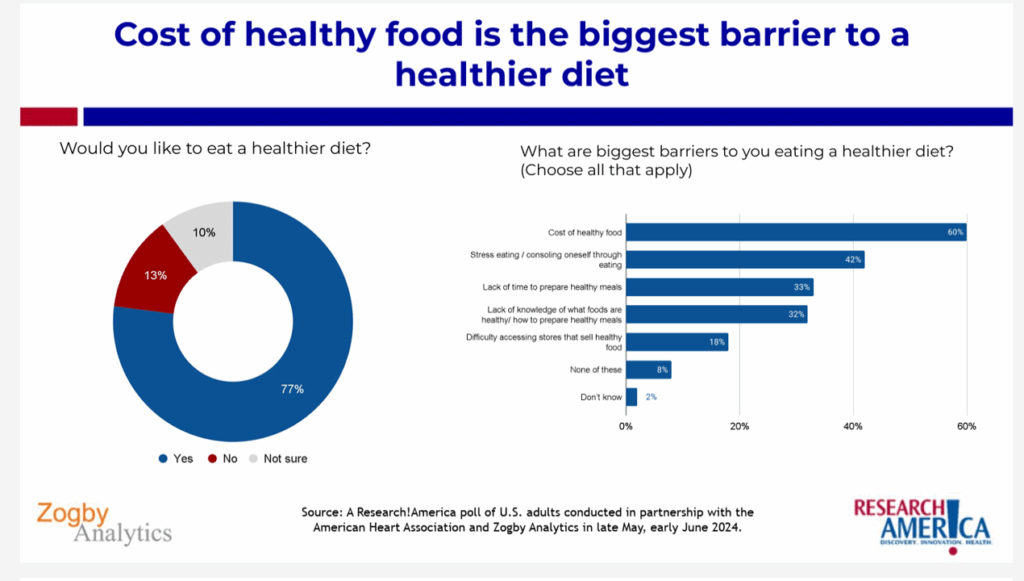It’s been a full week’s coverage on food-as-medicine and food as a driver of health in America this week on the Health Populi blog. Today we turn to the chefs at Escoffier who know food, teach food, and now offer programs in holistic nutrition and wellness through the lens of culinary arts. With that lens, Escoffier recently published a report on the future of healthy eating, which will round out this week’s Health Populi landscape on food and health. 
In the paper, the Escoffier team curated data points from many studies — via Gallup, Mintel, Innova, and most richly-mined, Research!America, a non-profit medical and health research advocacy alliance with dozens of leading organizations from academia, business, trade associations and professional societies, state of local organizations, and foundations and philanthropies.
It’s Research!America’s 2024 consumer survey that provided Escoffier’s opening context for U.S. consumers’ views on wellbeing, finding that most Americans are keen to eat a healthier diet. That’s the “spirit is willing” part of this post’s title.

But the flesh (and wallet, as it turns out) is/are weak when it comes to the cost of eating a healthier diet. 60% of people in the U.S. blame the cost of healthy eating the top barrier to doing so. Second, “stress eating” gets in the way of our eating healthfully, as many of us medicate ourselves through food — whether we deem it “comfort food” or otherwise. That’s part of our mental health which we know health consumers bundle in their overall definition of whole or holistic health, covered earlier this week here in Health Populi (here, on consumers’ need for evidence when buying into food-as-medicine from NielsenIQ, and here on consumers’ growing willingness to buy healthy food versus other categories of household spending – an illustration of the economic concept of “inelastic demand,” from McKinsey).
Tied for 3rd/4th place are the issues of lack of time to prepare healthy meals, and lack of knowledge of just what constitutes a healthy meal.

For 1 in 2 people in the U.S., it’s not very hard to source healthy food in the past year,
But for the other half of America, it’s hard — very hard for 1 in 10 people, generally hard for 1 in 10 people, and “somewhat” hard for 27%.

Team Escoffier wisely raises the issue of alcohol consumption, which has become a wellness issue especially among younger consumers. See this data from a Gallup survey, illustrating the very stark trend of young people 18-34 dropping in alcohol consumption by 13 percentage points in the 20-year period between 2001-04 to 2021-2024.
Stark, too, that older people 55+ increased their alcohol consumption in the two decades.
Escoffier discusses the growing beverage trends of non-alcoholic versions of traditional libations like “NA” (non-alcoholic beer, wine, and liquor. Underlying this trend is the demographic that more than 2 in 5 Americans between 18 and 34 abstain from alcohol totally, turning to the alternatives and fueling innovative trends in functional beverages — thought of as “alcohol adjacent.” Some of these embed mood-enhancing or wellness-focused ingredients such as CBD/THC and nootropics — with the segment growing double digits in each of the past two years. 
Health Populi’s Hot Points: Alcohol consumption is one of the original social determinants of health noted in the earliest definitions of SDoH — from Dr. Tony Iton doing research in Alameda County in the 1980s and onward.
Alcohol consumption is one of the most important modifiable behaviors for health improvement, among many behavior changes people can make to benefit their overall well-being.
So it is fascinating and encouraging to re-visit the Research!America data point from the 2024 survey that 75% of Americans say the U.S. should fund behavioral research. That overall number included 86% of Democrat voters, 66% of Republicans, and 72% of Independents.
This is striking as I write this post in early June 2025 as the current administration has cut and has further plans to reduce the funding of research for public health, medicine, and basic sciences.
This week I’ve covered three different research reports on U.S. consumers’ growing interest, spending and actions to study, shop for, and spend hard-earned dollars on food as inputs into personal and family health and well-being. To continue to grow these food-as-medicine muscles, health citizens will be keen to access the latest, best research and evidence available to inform their choices and lifestyles.
Note the bottom line statement on the last graphic, which comes from the Research!America report: “Improving quality of life and lowering health care costs are the most persuasive reasons to increase support for behavioral research.”
That is a concurrence across party IDs in the U.S. We’ll see more on this demand side through 2025 as patients-as-health-consumers and Chief Household Officers work hard to manage household budgets and fiscal/financial health. This is mainstream, kitchen table home economics that will persist — I anticipate both at home and at polling places come mid-terms in America in November 2026, as more people will be voting with health in mind, wallets in hand, and health citizenship on the ballot.




